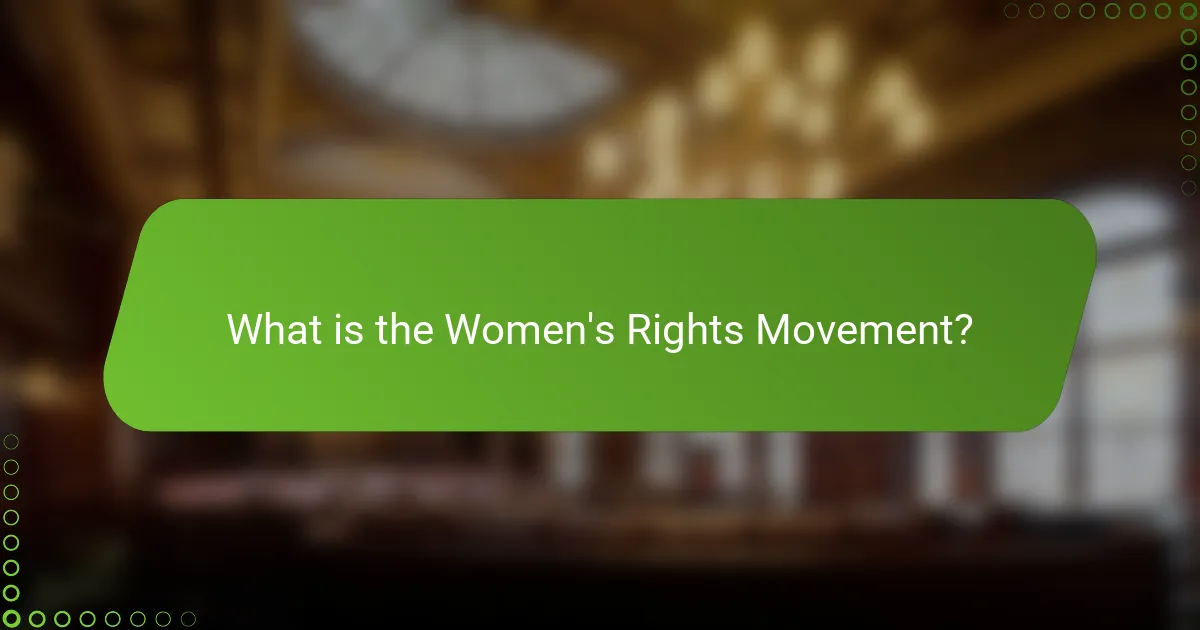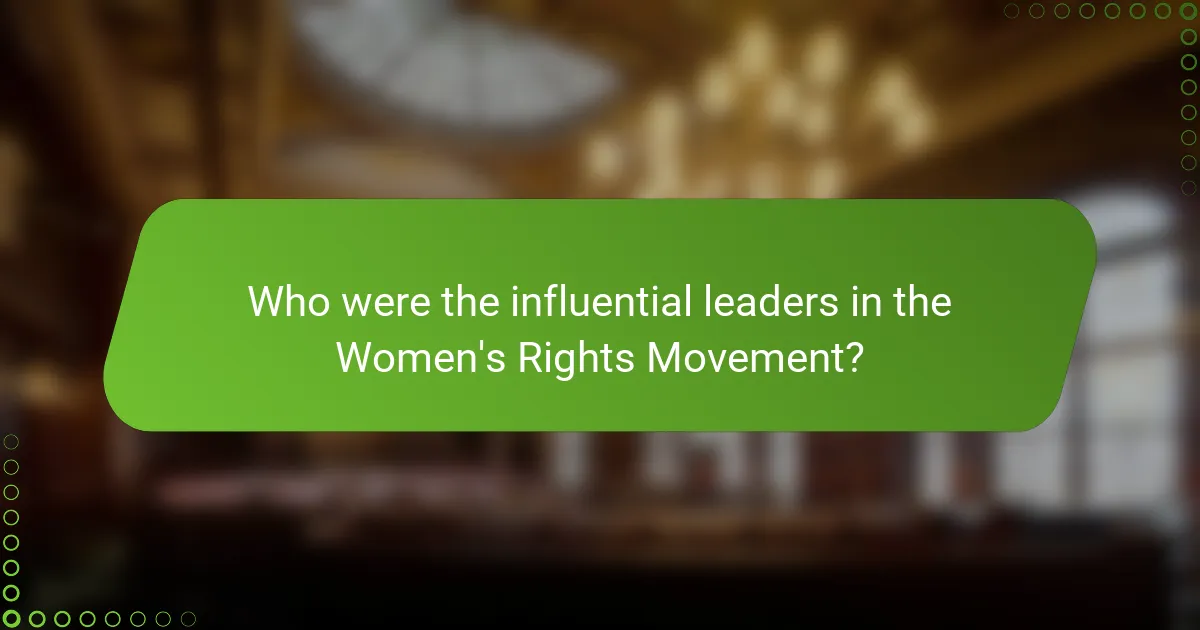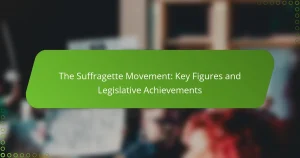The Women’s Rights Movement is a social and political campaign advocating for equal rights for women, focusing on issues such as voting rights, workplace equality, and reproductive rights. Key historical events include the Seneca Falls Convention in 1848, the ratification of the 19th Amendment in 1920, and the establishment of the National Organization for Women in 1966. Influential leaders such as Susan B. Anthony, Elizabeth Cady Stanton, and Sojourner Truth significantly shaped the movement’s trajectory. The movement has evolved to address ongoing challenges like pay equity and gender-based violence, remaining a critical force for social change and gender equality worldwide.

What is the Women’s Rights Movement?
The Women’s Rights Movement is a social and political campaign advocating for equal rights for women. It seeks to address issues such as voting rights, workplace equality, and reproductive rights. The movement gained momentum in the late 19th century with the Seneca Falls Convention in 1848. Key figures, including Susan B. Anthony and Elizabeth Cady Stanton, played significant roles in its development. The movement has evolved over time, addressing various forms of discrimination and inequality. Landmark achievements include the passage of the 19th Amendment in 1920, granting women the right to vote in the United States. Continued activism addresses ongoing challenges such as pay equity and gender-based violence. The Women’s Rights Movement remains a vital force for social change and gender equality globally.
How did the Women’s Rights Movement begin?
The Women’s Rights Movement began in the mid-19th century. It was sparked by the Seneca Falls Convention in 1848. This convention was organized by Elizabeth Cady Stanton and Lucretia Mott. Attendees demanded equal rights for women, including the right to vote. The Declaration of Sentiments was created during this gathering. It outlined grievances and called for gender equality. This event marked the formal start of the organized movement for women’s rights in the United States. Following this, various women’s rights organizations emerged to advocate for social and political change.
What were the early influences on the Women’s Rights Movement?
The early influences on the Women’s Rights Movement included the abolitionist movement and the Seneca Falls Convention. The abolitionist movement highlighted the inequalities faced by women and inspired activism for women’s rights. Key figures like Frederick Douglass supported women’s suffrage, emphasizing the connection between racial and gender equality. The Seneca Falls Convention in 1848 marked the first women’s rights convention in the U.S. It produced the Declaration of Sentiments, which outlined grievances and demands for women’s equality. This event galvanized the movement, leading to organized efforts for suffrage and legal rights. Prominent leaders like Elizabeth Cady Stanton and Lucretia Mott emerged from this convention, advocating for women’s rights. Their work laid the groundwork for future advancements in gender equality.
What key events marked the inception of the Women’s Rights Movement?
The Women’s Rights Movement began with key events that shaped its foundation. The Seneca Falls Convention in 1848 is often regarded as the movement’s starting point. This gathering produced the Declaration of Sentiments, which outlined grievances and demands for women’s rights. The convention was organized by Elizabeth Cady Stanton and Lucretia Mott. Another significant event was the publication of “Ain’t I a Woman?” by Sojourner Truth in 1851. This speech highlighted the intersection of race and gender issues. Additionally, the suffrage movement gained momentum with the formation of the National American Woman Suffrage Association in 1890. These events collectively marked the inception of the Women’s Rights Movement, advocating for equality and social justice.
Why is the Women’s Rights Movement important?
The Women’s Rights Movement is important because it advocates for gender equality and women’s rights. This movement has led to significant legal and social changes. For instance, women gained the right to vote in many countries, starting with New Zealand in 1893. The movement has also addressed issues like reproductive rights and workplace equality. Statistics show that women’s participation in the workforce has increased significantly since the 1960s. According to the World Bank, female labor force participation rose from 35% in 1990 to 48% in 2020 in many regions. The movement has also raised awareness about domestic violence and [censured] harassment. These changes have improved the quality of life for women globally. Overall, the Women’s Rights Movement has been crucial in shaping modern society.
What societal changes has the Women’s Rights Movement prompted?
The Women’s Rights Movement has prompted significant societal changes, including increased gender equality in various sectors. Women’s suffrage was achieved in many countries, allowing women to vote and participate in politics. Legal reforms have been enacted to address issues such as domestic violence and workplace discrimination. The movement has also led to greater representation of women in leadership roles across industries. Education access for women has expanded, resulting in higher literacy rates and professional opportunities. Public awareness of gender issues has increased, fostering societal discussions around equality. Cultural norms have shifted, promoting the idea of shared domestic responsibilities. Overall, the Women’s Rights Movement has fundamentally transformed societal perceptions of women’s roles.
How has the Women’s Rights Movement influenced modern gender equality?
The Women’s Rights Movement has significantly influenced modern gender equality. It laid the groundwork for legal reforms that promote equal rights. Landmark events, such as the Seneca Falls Convention in 1848, initiated the push for women’s suffrage. The movement led to the passage of the 19th Amendment in 1920, granting women the right to vote in the United States. This empowerment facilitated women’s participation in politics and public life. Additionally, the movement highlighted issues such as workplace discrimination and reproductive rights. The advocacy efforts resulted in legislation like the Equal Pay Act of 1963 and Title IX in 1972. These laws aimed to eliminate gender-based disparities in education and employment. Overall, the Women’s Rights Movement has been crucial in shaping policies that promote gender equality today.

What were the pivotal moments in the Women’s Rights Movement?
The pivotal moments in the Women’s Rights Movement include the Seneca Falls Convention in 1848. This event marked the first women’s rights convention in the United States. It produced the Declaration of Sentiments, which demanded equal rights for women. In 1920, the 19th Amendment was ratified, granting women the right to vote. The Equal Pay Act of 1963 aimed to abolish wage disparity based on [censured]. The establishment of the National Organization for Women (NOW) in 1966 was crucial for advocating women’s rights. The Roe v. Wade Supreme Court decision in 1973 recognized women’s rights to make decisions about their own bodies. The #MeToo movement, which gained prominence in 2017, highlighted [censured] harassment and assault issues. These moments collectively advanced the fight for gender equality and women’s rights.
What significant events shaped the course of the Women’s Rights Movement?
The Women’s Rights Movement was shaped by several significant events. The Seneca Falls Convention in 1848 marked the movement’s formal beginning. This event produced the Declaration of Sentiments, advocating for women’s suffrage and equality. The passage of the 19th Amendment in 1920 granted women the right to vote, a pivotal victory. The formation of the National Organization for Women (NOW) in 1966 played a crucial role in advocating for women’s rights in various spheres. The Roe v. Wade Supreme Court decision in 1973 affirmed women’s reproductive rights, influencing the movement significantly. The #MeToo movement, which gained traction in 2017, highlighted issues of [censured] harassment and assault, further energizing the fight for women’s rights. Each of these events contributed to the evolution and visibility of the Women’s Rights Movement.
How did the Seneca Falls Convention impact the movement?
The Seneca Falls Convention significantly advanced the women’s rights movement. It was the first women’s rights convention held in the United States in 1848. The convention produced the Declaration of Sentiments. This document outlined the grievances and demands of women, paralleling the Declaration of Independence. It called for equal rights, including the right to vote. The convention galvanized activists and inspired future suffrage movements. Key figures like Elizabeth Cady Stanton and Lucretia Mott emerged as leaders. The event marked a formal beginning to organized women’s activism in America. Its impact resonated throughout the 19th and 20th centuries, shaping the fight for gender equality.
What role did women’s suffrage play in advancing rights?
Women’s suffrage played a crucial role in advancing rights by granting women the legal right to vote. This milestone empowered women to influence political processes and advocate for broader social changes. The suffrage movement highlighted issues such as gender equality and civil rights. It mobilized women across various demographics, fostering solidarity and activism. In the United States, the 19th Amendment, ratified in 1920, legally enfranchised women. This legislative change marked a significant step toward gender equality in civic participation. Women’s voting rights also laid the groundwork for subsequent movements advocating for equal rights in other areas, such as employment and education. The suffrage movement’s legacy continues to influence contemporary discussions on women’s rights.
What landmark legislation resulted from the Women’s Rights Movement?
The landmark legislation that resulted from the Women’s Rights Movement is the Equal Pay Act of 1963. This act aimed to abolish wage disparity based on [censured]. It mandated that men and women receive equal pay for equal work in the same establishment. The Equal Pay Act was a significant step towards achieving gender equality in the workplace. It was signed into law by President John F. Kennedy. The act was part of a broader effort to address discrimination against women. It laid the groundwork for future legislation aimed at protecting women’s rights. The passage of this act marked a pivotal moment in the Women’s Rights Movement.
What laws have been enacted to support women’s rights?
The laws enacted to support women’s rights include the Equal Pay Act of 1963. This law mandates equal pay for equal work, addressing wage discrimination based on gender. The Title IX of the Education Amendments of 1972 prohibits [censured]-based discrimination in federally funded education programs. The Violence Against Women Act of 1994 provides legal protections against domestic violence and [censured] assault. The Pregnancy Discrimination Act of 1978 prohibits discrimination based on pregnancy, childbirth, or related medical conditions. The Women’s Health and Cancer Rights Act of 1998 ensures coverage for breast reconstruction after mastectomy. These laws collectively enhance women’s rights in various domains, from employment to education and health care.
How have these laws changed societal perceptions of women’s roles?
Laws advocating for women’s rights have significantly altered societal perceptions of women’s roles. These laws have promoted gender equality and challenged traditional stereotypes. For instance, the passing of the Equal Pay Act in 1963 highlighted the importance of equal compensation for women. This legislation underscored women’s contributions to the workforce. Additionally, the Title IX Education Amendments of 1972 transformed perceptions in education by ensuring equal opportunities for women. Such legal advancements have empowered women to pursue careers and education previously dominated by men. Research indicates that societies with progressive women’s rights laws exhibit higher levels of gender equality. This shift in perception has led to increased representation of women in leadership positions across various sectors.

Who were the influential leaders in the Women’s Rights Movement?
Influential leaders in the Women’s Rights Movement include Susan B. Anthony, Elizabeth Cady Stanton, and Sojourner Truth. Susan B. Anthony played a crucial role in advocating for women’s suffrage. She co-founded the National Woman Suffrage Association in 1869. Elizabeth Cady Stanton was a prominent suffragist and activist. She organized the Seneca Falls Convention in 1848, which marked the start of the organized women’s rights movement. Sojourner Truth was an important figure as well. Her famous speech “Ain’t I a Woman?” highlighted the intersection of race and gender issues. These leaders significantly shaped the movement and fought for women’s rights throughout the 19th and early 20th centuries.
What contributions did key figures make to the Women’s Rights Movement?
Key figures made significant contributions to the Women’s Rights Movement. Susan B. Anthony played a crucial role in advocating for women’s suffrage. She co-founded the National Woman Suffrage Association in 1869. Elizabeth Cady Stanton was instrumental in organizing the Seneca Falls Convention in 1848. This event marked the beginning of the organized women’s rights movement in the United States. Sojourner Truth delivered her famous “Ain’t I a Woman?” speech in 1851, highlighting the intersection of race and gender issues. Alice Paul founded the National Woman’s Party in 1916, focusing on a more militant approach to securing women’s voting rights. These leaders and their actions were pivotal in advancing women’s rights and achieving significant legal reforms.
How did Susan B. Anthony influence the movement?
Susan B. Anthony significantly influenced the women’s rights movement through her activism and leadership. She co-founded the National Woman Suffrage Association in 1869. This organization focused on securing women’s right to vote. Anthony also traveled extensively to speak on women’s rights. She organized rallies and conventions to raise awareness. In 1872, she was arrested for voting illegally. This act of civil disobedience highlighted the injustices faced by women. Anthony’s efforts helped to mobilize public support for suffrage. Her work laid the groundwork for future advancements in women’s rights.
What legacy did Elizabeth Cady Stanton leave behind?
Elizabeth Cady Stanton left a profound legacy in the women’s rights movement. She co-founded the National Woman Suffrage Association in 1869. Stanton was a key figure in organizing the Seneca Falls Convention in 1848. This convention marked the first women’s rights convention in the United States. Her Declaration of Sentiments outlined the grievances and demands for women’s rights. Stanton advocated for women’s suffrage, property rights, and education. She also collaborated with Susan B. Anthony, amplifying the movement’s reach. Stanton’s writings, including “The Woman’s Bible,” challenged traditional views on gender roles. Her efforts laid the groundwork for future advancements in women’s rights.
What strategies did leaders use to advance the Women’s Rights Movement?
Leaders advanced the Women’s Rights Movement through advocacy, organization, and legislation. They organized rallies and marches to raise awareness about women’s issues. Notable events include the Seneca Falls Convention in 1848, which was the first women’s rights convention. Leaders like Susan B. Anthony and Elizabeth Cady Stanton campaigned for suffrage and legal rights. They utilized publications, such as “The Revolution,” to spread their message. Grassroots organizing helped mobilize support from diverse communities. Legal challenges were also employed to contest discriminatory laws. These strategies collectively contributed to significant advancements in women’s rights over time.
How did grassroots organizing shape the movement’s success?
Grassroots organizing significantly shaped the Women’s Rights Movement’s success by mobilizing local communities and fostering widespread participation. This approach empowered individuals to advocate for their rights and connect with larger national goals. Grassroots efforts often led to increased visibility for women’s issues in local and national discourse. Events like rallies and meetings created a sense of solidarity among participants. The formation of local chapters allowed for tailored strategies that addressed specific community needs. Furthermore, grassroots organizing cultivated leadership skills among women, enabling them to take on influential roles. Historical examples include the Seneca Falls Convention in 1848, which galvanized support for women’s suffrage. The collective action generated through grassroots efforts was crucial in pressuring lawmakers to enact reforms.
What role did public speaking and writing play in advocacy?
Public speaking and writing were crucial tools in advocacy during the Women’s Rights Movement. They enabled leaders to articulate demands for equality and justice. Speeches and writings inspired collective action and galvanized public support. Notable figures like Susan B. Anthony and Elizabeth Cady Stanton used these mediums effectively. Their speeches at conventions drew large audiences and media attention. Publications like “The Revolution” disseminated feminist ideas widely. These efforts helped to challenge societal norms and mobilize grassroots movements. Public speaking and writing were instrumental in shaping public opinion and policy changes.
What lessons can be learned from the Women’s Rights Movement?
The Women’s Rights Movement teaches the importance of advocacy and collective action. It demonstrates that organized efforts can lead to significant legal and social changes. For example, the 19th Amendment, ratified in 1920, granted women the right to vote in the United States. This achievement resulted from decades of activism and collaboration among various women’s groups.
Additionally, the movement highlights the necessity of intersectionality. Women of different races, classes, and backgrounds faced unique challenges. Recognizing these differences was crucial for creating inclusive strategies. The movement also underscores the ongoing nature of fighting for rights. Progress can be slow and requires sustained effort over time.
Moreover, the Women’s Rights Movement illustrates the power of education and awareness. Informing the public about gender inequality helped garner support. Campaigns and literature raised consciousness about women’s issues. These lessons remain relevant as modern movements continue to seek equality and justice.
How can current movements for equality apply these lessons?
Current movements for equality can apply lessons from the Women’s Rights Movement by emphasizing grassroots organizing. Historical movements showed that local action can lead to significant change. For example, the suffragette movement effectively mobilized communities to advocate for voting rights. Additionally, current movements can adopt strategies of coalition-building seen in past efforts. The Civil Rights Movement successfully allied with various groups to amplify its impact. Furthermore, learning from historical leaders can inspire modern activists. Figures like Susan B. Anthony demonstrated the importance of persistence and strategic advocacy. Finally, leveraging social media for awareness mirrors the pamphlets and publications used in earlier movements. These methods collectively enhance the effectiveness of contemporary equality movements.
What best practices emerged from the Women’s Rights Movement?
Best practices that emerged from the Women’s Rights Movement include grassroots organizing, coalition-building, and strategic advocacy. Grassroots organizing mobilized communities to raise awareness and drive change. Coalition-building united diverse groups to amplify voices and strengthen efforts. Strategic advocacy focused on legislative reforms and policy changes to ensure women’s rights. These practices were evident in key events such as the Seneca Falls Convention in 1848, which laid the groundwork for future activism. The movement’s success in securing the right to vote through the 19th Amendment in 1920 exemplifies the effectiveness of these best practices.
The Women’s Rights Movement is a social and political campaign advocating for equal rights for women, addressing issues such as voting rights, workplace equality, and reproductive rights. Key historical events, including the Seneca Falls Convention in 1848 and the ratification of the 19th Amendment in 1920, marked significant milestones in the movement’s evolution. Influential leaders like Susan B. Anthony, Elizabeth Cady Stanton, and Sojourner Truth played pivotal roles in advancing women’s rights through advocacy, public speaking, and grassroots organizing. The movement has prompted substantial societal changes, leading to landmark legislation and increased awareness of gender issues, while its lessons continue to inform contemporary equality movements.




